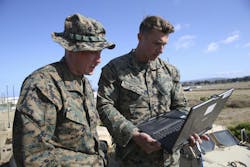Military researchers eye energy-efficient approaches to power-hungry machine learning on the battlefield
Summary points:
- ML2P program aims to create machine learning systems that deliver advanced capabilities without overloading limited battery and generator power.
- Initiative seeks innovative, physics-informed approaches to cut the massive electricity demands of modern deep learning.
- Goal is to build energy-aware machine learning that can predict and optimize power use in resource-constrained combat environments.
ARLINGTON, Va. – U.S. military researchers are preparing a new program to develop energy-efficient machine learning capabilities for use in austere environments on the leading edge of the battlefield.
Officials of the U.S. Defense Advanced Research Projects Agency (DARPA) in Arlington, Va., issued a special notice (DARPA-SN-25-101) on Friday to inform industry of the forthcoming Mapping Machine Learning to Physics (ML2P) program.
ML2P seeks to develop an innovative, sustainable approach to power-hungry battlefield machine learning that does not hog the limited electricity on the battlefield that typically comes from batteries and generators.
Power-hungry machine learning
Machine learning technology today uses an inordinate amount of electricity, which could overwhelm current power generation and storage capabilities on the battlefield. The ML2P program seeks to make machine learning technologies that energy-efficient enough for the limited resources of the battlefield.
To sustain innovation without compromising energy resources, the ML2P program seeks to develop an innovative and sustainable approach to machine learning.
Machine learning at the edge operates in a resource-constrained battlefield, which requires electrical efficiency. The solution could involve new generations energy-aware machine learning.
Tell me more about the need for machine learning on the battlefield ...
- Driving the need for machine learning on the battlefield is the increasing complexity, speed, and data-driven nature of modern warfare. Machine learning on the battlefield lends itself to fast decision-making; alleviating data overload; enhanced target recognition and tracking; machine autonomy; cyber security and electronic warfare (EW); predictive maintenance and logistics; and psychological and information warfare. Machine learning -- especially large-scale deep learning -- burns through a lot of electricity because it’s doing a mind-boggling amount of math quickly across thousands or millions of parameters and training examples.
DARPA researchers expect the resulting approaches will be useful for air-, land-, and sea-based uncrewed vehicles, which have limited battery capacities that must serve mission needs that include propulsion, communications, data processing, and mission planning.
The ML2P program seeks to enable accurate predictions of the power and performance of future machine learning models that understand power consumption throughout the machine learning life cycle. This will drive development of more energy-efficient military computing, researchers say. ML2P will build energy-aware machine learning that provides trade-offs between power and performance to enable energy-aware machine learning.
DARPA has not officially begun the ML2P program. This announcement only is to announce the agency's intentions about a future project. Companies that would like to make their interest known should email DARPA no later than 5 Sept. 2025 at [email protected]. More information is online at https://sam.gov/opp/c6233393d88d450ebf942f87430516fe/view.
About the Author
John Keller
Editor-in-Chief
John Keller is the Editor-in-Chief, Military & Aerospace Electronics Magazine--provides extensive coverage and analysis of enabling electronics and optoelectronic technologies in military, space and commercial aviation applications. John has been a member of the Military & Aerospace Electronics staff since 1989 and chief editor since 1995.

